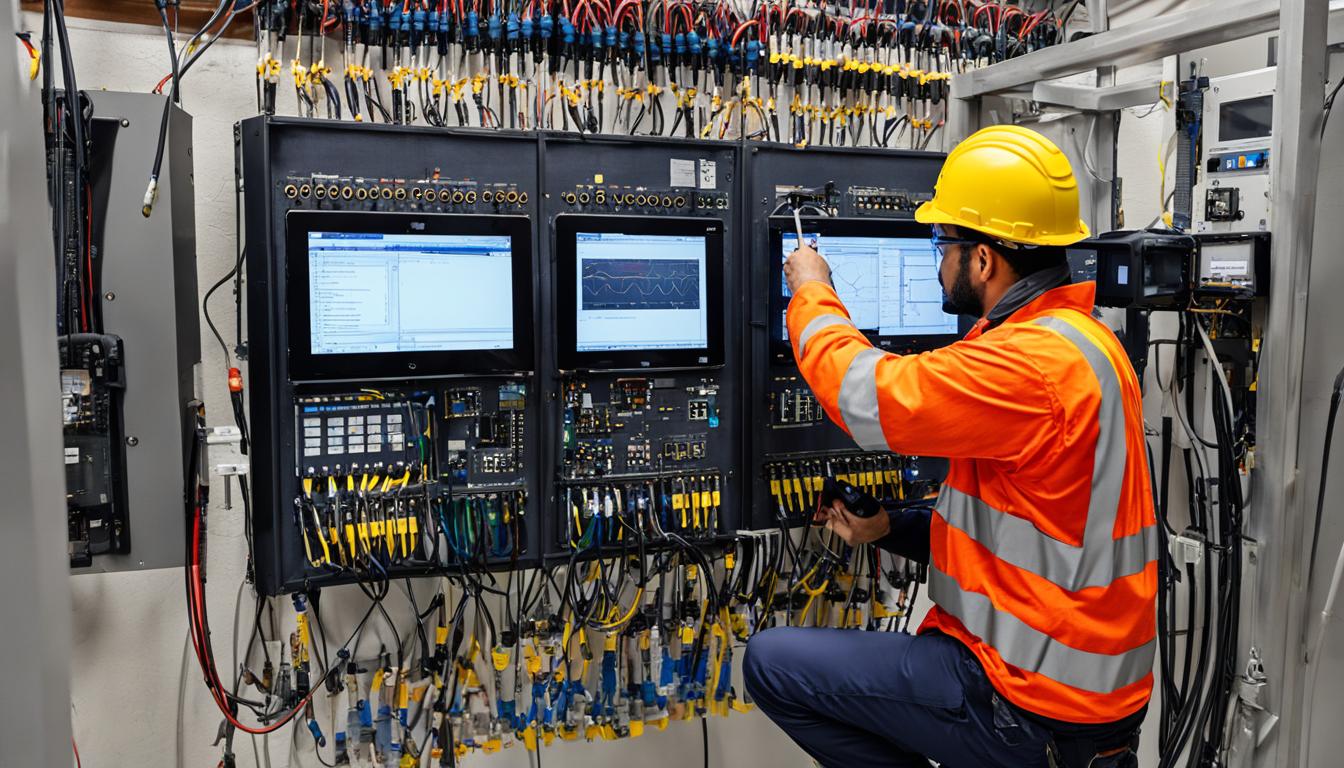Are you familiar with site surveys in information technology (IT)? If not, it’s time to dive into this crucial aspect of project planning. Site surveys play a vital role in ensuring the success and safety of IT projects by providing valuable insights into the attributes and conditions of the site where the project will take place.
So, what exactly is a site survey in IT? It involves visiting the physical location of the project and collecting data and information about the site. This data helps businesses make informed decisions about construction, network coverage, and other IT projects. Site surveys are essential in understanding the site’s possibilities and limitations, enabling businesses to plan and execute projects effectively.
Why are site surveys so important in IT? The answer lies in their benefits and purpose. By conducting a site survey, businesses can:
- Identify potential obstacles and hazards in the area.
- Ensure sufficient equipment and supplies for the project.
- Save money by eliminating unnecessary costs.
- Gain feedback from users and visitors, enhancing user satisfaction.
- Create a foundation for project scope and design documentation.
Ultimately, site surveys provide a comprehensive understanding of the site, enabling remote collaboration and decision-making among project stakeholders.
Contents
- 1 The Site Survey Process in IT
- 2 Benefits of Conducting Site Surveys in IT
- 3 Best Practices for Conducting Site Surveys in IT
- 4 The Site Survey Checklist in IT
- 5 Conclusion
- 6 FAQ
- 6.1 What is a site survey in information technology?
- 6.2 What is the importance of a site survey in IT?
- 6.3 What is the purpose of a site survey in information technology?
- 6.4 What is the site survey process in IT?
- 6.5 What are the benefits of conducting site surveys in IT?
- 6.6 What are the best practices for conducting site surveys in IT?
- 6.7 What is the site survey checklist in IT?
- 7 Source Links
Key Takeaways:
- Site surveys are a crucial part of project planning in IT.
- They provide valuable insights into the attributes and conditions of the site.
- Site surveys help businesses make informed decisions about construction and network coverage.
- Conducting a thorough and accurate site survey is essential for project success and safety.
- Using a site survey checklist and tools can streamline the process and ensure nothing is overlooked.
The Site Survey Process in IT
The site survey process in information technology is a crucial step in gathering data, understanding user needs, and making informed decisions. This process involves several key steps that ensure a comprehensive survey is conducted.
- Start with a floor plan: When available, begin by reviewing the floor plan of the area to be surveyed. This provides a visual representation of the space and helps in identifying key areas of interest.
- Conduct a site visit: A site visit or walkthrough is essential to get an up-close look at the area. During this visit, it is important to understand the purpose of each space and identify the strongest signal sources in the area. This helps in determining the coverage requirements and optimizing network performance.
- Check for potential interference sources: While conducting the survey, it is necessary to check for potential interference sources that could weaken the signal strength. This includes identifying walls, windows, or other physical barriers that may affect network coverage. By addressing these issues, the overall network performance can be improved.
- Utilize different survey techniques: There are various site survey techniques that can be employed. Predictive surveys use software models to predict coverage, providing insights into network performance. Active surveys involve testing with actual devices in real-world conditions, allowing for a more accurate assessment of coverage and performance.
- Follow best practices for on-site surveys: To ensure meaningful responses from users, it is important to consider timing, targeting, and approach for triggering on-site surveys. By selecting appropriate question types, such as explicit questions, scales, and ratings, and implicit questions, businesses can gather insightful data.
- Determine the sample size: Determining the sample size for surveys is crucial in ensuring statistical significance. Factors such as traffic levels and user demographics should be considered when determining the appropriate sample size.
By following these site survey techniques and best practices, businesses can gather accurate data, understand user requirements, and make informed decisions. The site survey process in IT is essential for optimizing network performance, identifying potential issues, and ensuring the success of IT projects.
Take a look at the table below for a visual representation of the site survey process in IT:
| Steps | Description |
|---|---|
| 1 | Start with a floor plan |
| 2 | Conduct a site visit |
| 3 | Check for potential interference sources |
| 4 | Utilize different survey techniques |
| 5 | Follow best practices for on-site surveys |
| 6 | Determine the sample size |
Benefits of Conducting Site Surveys in IT
Conducting site surveys in information technology brings several important benefits. These surveys provide valuable insights into an area, enabling businesses to make informed decisions about construction, network coverage, and other IT projects. By conducting thorough site surveys, businesses can save money by ensuring they have the necessary equipment and supplies for a project, while also eliminating unnecessary costs.
One of the key advantages of conducting site surveys is the ability to gather accurate feedback from visitors and customers. By understanding their experiences and expectations, businesses can improve user satisfaction and enhance website performance. Site surveys help identify areas for improvement, allowing businesses to make necessary adjustments and provide a better user experience.
Using a site survey checklist is crucial to ensure that all necessary aspects of the survey are considered and nothing is overlooked. A comprehensive checklist includes items such as securing permission to access the site, identifying obstacles, testing equipment, taking measurements, and noting special conditions or safety considerations. By following the checklist, businesses can conduct thorough and accurate site surveys.
| Benefits of Conducting Site Surveys in IT |
|---|
| Make informed decisions about construction and network coverage |
| Save money by ensuring sufficient equipment and supplies |
| Gather accurate feedback to improve user satisfaction |
| Enhance website performance by understanding user expectations |
In addition to using a checklist, there are various site survey tools available that can streamline the survey process and enhance data collection and analysis. These tools automate data gathering, provide visual representations of site conditions, and facilitate collaboration among project stakeholders.
In conclusion, conducting site surveys in IT is essential for project success, user satisfaction, and cost savings. The insights gained from site surveys enable businesses to make informed decisions, optimize resources, and improve user experiences. By using a site survey checklist and leveraging site survey tools, businesses can ensure accurate data collection and streamline the survey process.

Having highlighted the importance of site surveys in IT projects, let’s explore best practices for conducting these surveys. It entails understanding the site survey process, employing accurate techniques, and using comprehensive checklists and tools to streamline the process and gather valuable insights.
Best Practices for Conducting Site Surveys in IT
When conducting site surveys in IT, it is crucial to follow best practices to ensure accuracy and effectiveness. By implementing these practices, you can gather valuable insights and make informed decisions for your projects. Here are some key best practices to consider:
- Determine the top-level goal: Before starting the survey, clearly define the purpose and objectives. This will help you focus on gathering the most relevant data for your project.
- Use a site survey checklist: A comprehensive checklist ensures that all necessary aspects of the survey are covered. It helps you remember important steps, such as securing permission to access the site, identifying obstacles, testing equipment, taking measurements, and noting special conditions or safety considerations.
- Consider timing, targeting, and approach: Determine the best timing to trigger on-site surveys to get meaningful responses from users. Target specific pages or areas that are most relevant to your project. Choose an approach that encourages user participation and provides accurate data.
- Employ different survey techniques: Depending on your project requirements, you can use various survey techniques. Predictive surveys utilize software models to forecast coverage, while active surveys involve testing with actual devices in real-world conditions. This diversity of techniques helps gather comprehensive insights.
- Use a combination of question types: To extract the most valuable information, incorporate a mix of explicit, single response questions, scales and ratings, and implicit questions. This approach offers a well-rounded understanding of user needs and preferences.
- Determine the appropriate sample size: To ensure statistical significance, carefully consider the sample size for your surveys. Factors such as traffic levels and project scope should inform your decision, allowing for accurate data analysis and informed decision-making.
By following these best practices, you can conduct effective and informative site surveys in IT. The insights you gather will support project planning, remote collaboration, and enable you to make well-informed decisions. Remember to continuously refine your approach based on feedback and evolving project requirements.

Implementing best practices for site surveys will help you gather accurate data and make informed decisions for your IT projects.
The Site Survey Checklist in IT
The site survey checklist is a crucial tool in conducting comprehensive site surveys in IT. It provides a set of criteria and items that need to be considered and measured to ensure that all necessary aspects of the survey are covered.
By using a site survey checklist, businesses can ensure that every aspect of their survey is considered and that nothing is overlooked. This helps in making better decisions about construction, network coverage, and other IT projects.
The checklist typically includes items such as:
- Securing permission to access the space
- Identifying obstacles
- Testing equipment
- Taking measurements
- Noting special conditions or safety considerations
Using a comprehensive site survey checklist ensures that businesses gather accurate and relevant data, allowing them to make informed decisions based on the survey findings.

There are also site survey tools available that can assist in creating and implementing checklists, streamlining the process, and ensuring accuracy. These tools help businesses collect, organize, and analyze site survey data effectively.
Overall, the site survey checklist is a valuable resource for businesses conducting site surveys in IT. It provides a systematic approach to gather data and information, helping businesses make informed decisions and successfully execute their IT projects.
Conclusion
Site surveys are an essential component of information technology projects. They provide valuable insights into the attributes and conditions of a site, enabling businesses to make informed decisions and effectively plan their projects. By following the site survey process, best practices, and utilizing a comprehensive checklist, you can conduct accurate and informative site surveys.
The data collected from site surveys facilitates remote collaboration and decision-making among project stakeholders, supporting the planning and execution of IT projects. Additionally, implementing site survey techniques and tools can streamline the survey process, enhancing data collection and analysis.
Overall, site surveys play a critical role in ensuring project success, user satisfaction, and cost savings. By conducting thorough site surveys, you can execute projects successfully, meet user needs, and utilize resources effectively. So, make site surveys an integral part of your IT projects and unlock valuable insights that will contribute to your overall success.
FAQ
What is a site survey in information technology?
A site survey in information technology involves visiting the physical location where a project will take place and collecting data and information about the site. It helps businesses gather insights into the attributes and conditions of the site, which are crucial for making informed decisions about construction, network coverage, and other IT projects.
What is the importance of a site survey in IT?
Site surveys are important in IT projects because they provide valuable insights into the site, ensuring project success and safety. They help businesses save money by identifying potential issues and eliminating unnecessary costs. Site surveys also provide the foundation for project scope and design documentation and enable remote collaboration and decision-making among project stakeholders.
What is the purpose of a site survey in information technology?
The purpose of a site survey in information technology is to gather data and information about a physical location to support project planning and decision-making. It helps businesses understand the attributes and conditions of the site, identify potential obstacles or hazards, and ensure the necessary resources and equipment are available for the project.
What is the site survey process in IT?
The site survey process in IT typically involves several steps, including starting with a floor plan (when available), conducting a site visit or walkthrough, understanding the purpose of each space, identifying strong signal sources, checking for potential interference sources, and using different site survey techniques such as predictive surveys and active surveys to gather data and insights for effective project planning.
What are the benefits of conducting site surveys in IT?
Conducting site surveys in IT provides several benefits. It allows businesses to make informed decisions about construction, network coverage, and other IT projects. Site surveys help save money by ensuring sufficient equipment and supplies for a project and eliminating unnecessary costs. They also enable businesses to gather feedback from users, improving user satisfaction and website performance.
What are the best practices for conducting site surveys in IT?
Some best practices for conducting site surveys in IT include determining the top-level goal of the survey, following a comprehensive checklist, considering timing, targeting, and approach for triggering on-site surveys, choosing appropriate question types, and determining the sample size for surveys. These practices help ensure accuracy, collect meaningful insights, and streamline the survey process.
What is the site survey checklist in IT?
The site survey checklist in IT is a valuable tool that helps ensure all necessary aspects of a site survey are considered and measured. It includes items such as securing permission to access the site, identifying obstacles, testing equipment, taking measurements, and noting special conditions or safety considerations. Using a site survey checklist helps in making better decisions about construction, network coverage, and other IT projects.




